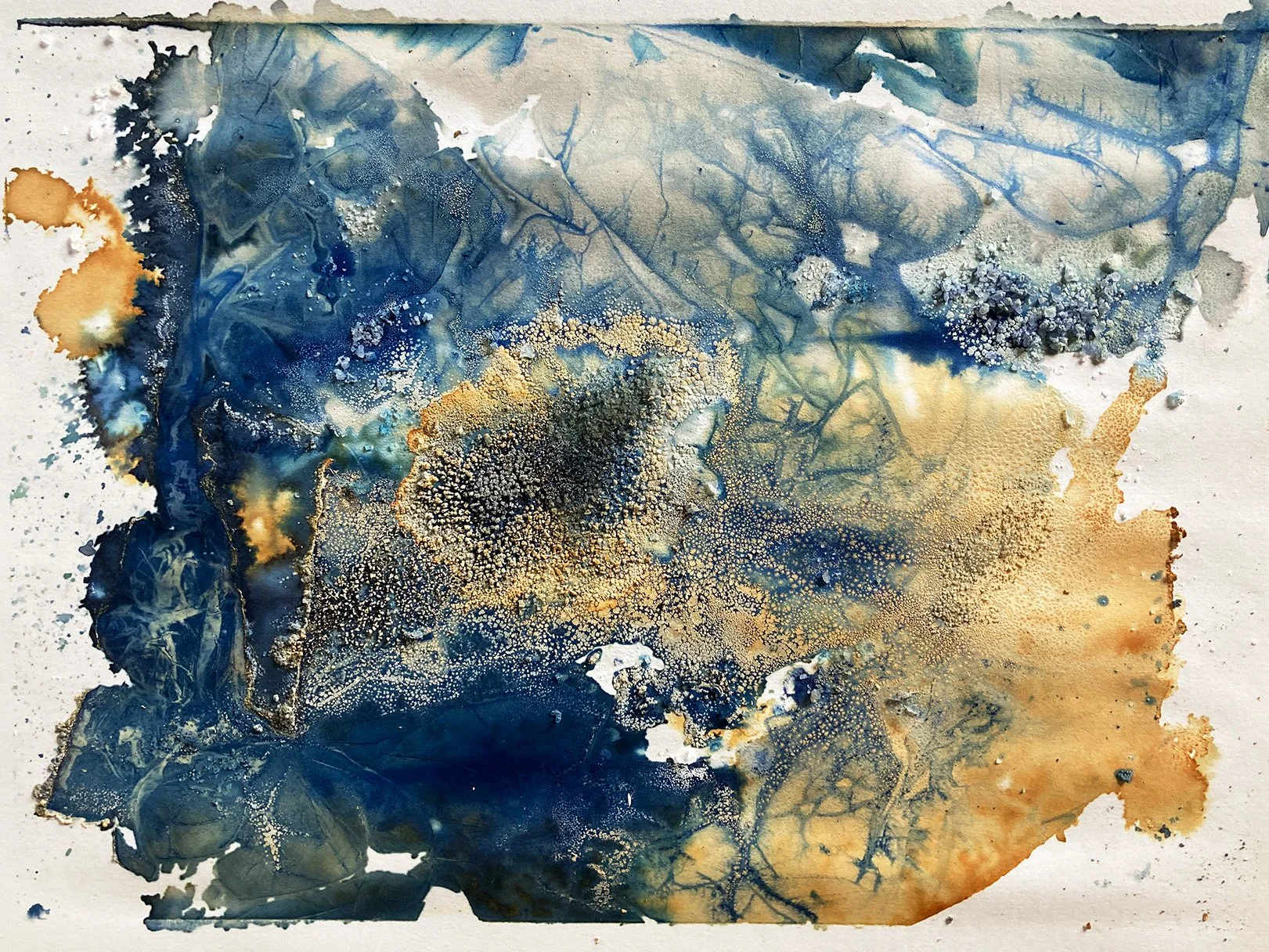Deep Time
It all begins with an idea. . .what if I break with convention and take an entirely different approach to producing cyanotypes images? What if I don't premix the chemicals in equal quantities, but rather treat them like watercolour paint?
Deep Time #I, Individual Cyanotype Chemicals and Salt on Paper
Back to pushing boundaries and seeing what could be achieved with experimental cyanotypes. In this series of pieces I wanted to try and establish how much control, if any, could be used to create an interesting abstract image.
Again as in previous efforts only the two individual chemicals, a few small sprays of tap water, salt and cling film were used. They were then placed in the daylight until I felt they had been sufficiently exposed and then removed to my studio were they were placed out of direct light and left overnight.
The following morning, and it’s always with some trepidation, I re-entered my studio to remove the cling film and to see how things were progressing. It appears to be normal, on such occasions, to find that the paper is not completely dry and as such the process is not entirely complete — subtle changes may continue to occur. In fact, as the process is unwashed to preserve the presence of the salt crystals there is a possibility using this method could result in artworks that continue to change and develop over time.
Deep Time #II, Individual Cyanotype Chemicals and Salt on Paper
Deep Time #III, Individual Cyanotype Chemicals and Salt on Paper
Deep Time #IV, Individual Cyanotype Chemicals and Salt on Paper
Deep Time #V, Individual Cyanotype Chemicals and Salt on Paper
The idea that these images could continue to change and develop in different directions is an intriguing one, but only time will tell. Of course if the changes are subtle they could go unnoticed. It’s also worth considering as to whether any changes, no matter how subtle, would have a detrimental effect on these pieces of art.
Experimental Cyanotypes
It all begins with an idea.
My initial interest in an alternative method of working with cyanotypes was inspired by an online course provided by the artist Natalie Day. Since last summer I have been experimenting with different ways of using the cyanotype chemicals and have been concentrating on methods which are more akin to working with watercolour, as well as experimenting with the exposure times. The images that I have been able to create are both expressive and totally unique.
Deciding whereabouts to place the individual chemicals, bearing mind that they are very similar in colour prior to exposure, got more difficult as more drops were added. Salt was sprinkled liberally across certain areas, followed by a light spray or two of water, and finally pieces of cling film.
Like all my experimental cyanotypes, it was exposed to daylight until I was happy with how it had progressed. Once it was brought into the studio, it was placed in an area of subdued lighting. In the case of this particular piece there were one or two interesting effects happening on the surface of the cling film — salt crystals were developing on the surface of the cling film, even though the area was quite small, about 1 x 2cms, I felt they were worthy of a photograph and you can see the result in the digital photograph, Abstract #1.
Unlike normal cyanotypes this image has not been washed, and the colours seem to have stabilised.
Alternative Photographic Processes
Photography is something that I have always been interested in, probably stemming from the time as a child that my Granny would get out an old handbag and show me photographs of relatives from the late 1800’s, through to her parents, herself and her siblings and then more recent images. I love the sheen you get on very old photographs and the fact that some are printed onto thick card with name and address of the photographer on the back, and in some cases they are ‘engraved’ with the marks that come from a ‘life lived’.
Having previously enjoyed the process of developing, printing and enhancing black and white photographs I became fascinated with alternative photographic processes while working on my degree. Although I did not have time to pursue this at that time, I was intrigued by the possibility of creating images without the need for a camera and it was at the end of 2019 that I was able to take part in a one day workshop on cyanotypes at the Inverness Dark Room.
Since learning the basics I have been taking part in an online ‘Experimental Cyanotypes’ workshop tutored by Natalie Day, and am now attempting to experiment further, developing my own ideas in an effort to see how far the cyanotype process can be pushed, by how much and in what way.








